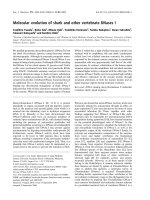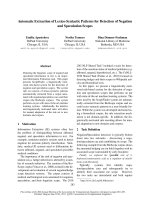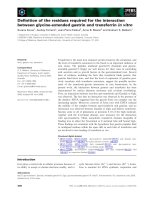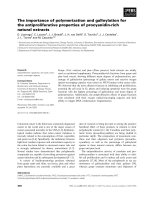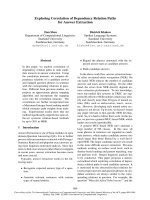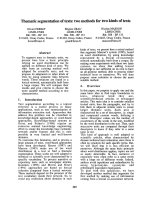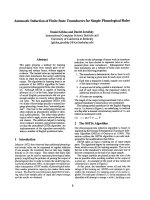Báo cáo khoa học: "Clinical outcomes of stereotactic body radiotherapy for stage I non-small cell lung cancer using different doses depending on tumor size" ppsx
Bạn đang xem bản rút gọn của tài liệu. Xem và tải ngay bản đầy đủ của tài liệu tại đây (262.68 KB, 7 trang )
RESEARC H Open Access
Clinical outcomes of stereotactic body
radiotherapy for stage I non-small cell lung
cancer using different doses depending on
tumor size
Fumiya Baba
1,2*
, Yuta Shibamoto
1
, Hiroyuki Ogino
1
, Rumi Murata
1
, Chikao Sugie
1
, Hiromitsu Iwata
1
, Shinya Otsuka
1
, Katsura Kosaki
1
, Aiko Nagai
1
, Taro Murai
1
, Akifumi Miyakawa
1
Abstract
Background: The treatment schedules for stereotactic body radiotherapy (SBRT) for lung cancer vary from
institution to institution. Several reports have indicated that stage IB patients had worse outcomes than stage IA
patients when the same dose was used. We evaluated the clinical outcomes of SBRT for stage I non-small cell lung
cancer (NSCLC) treated with different doses depending on tumor diameter.
Methods: Between February 2004 and November 2008, 124 patients with stage I NSCLC underwent SBRT. Total
doses of 44, 48, and 52 Gy were administered for tumors with a longest diameter of less than 1.5 cm, 1.5-3 cm,
and larger than 3 cm, respectively. All doses were given in 4 fractions.
Results: For all 124 patients, overall survival was 71%, cause-specific survival was 87%, progression-free survival was
60%, and local control was 80%, at 3 years. The 3-year overall survival was 79% for 85 stage IA patients treated
with 48 Gy and 56% for 37 stage IB patients treated with 52 Gy (p = 0.05). At 3 years, cause-specific survival was
91% for the former group and 79% for the latter (p = 0.18), and progression-free survival was 62% versus 54% (p =
0.30). The 3-year local control rate was 81% versus 74% (p = 0.35). The cumulative incidence of grade 2 or 3
radiation pneumonitis was 11% in stage IA patients and 30% in stage IB patients (p = 0.02).
Conclusions: There was no difference in local control between stage IA and IB tumors despite the difference in
tumor size. The benefit of increasing the SBRT dose for larger tumors shoul d be investigated further.
Background
Stereotactic body radiotherapy (SBRT) for lung t umors
wasintroducedinthemid1990s[1],andithasbeen
performed in many institutions as a new treatment
modality for stage I primary lung cancer and oligometa-
static lung cancer. Promising clinical results have been
reported despite the use of various treatment protocols
[2-9]. According to a recently published survey of SBRT
in Japan, the treatment techniques and sc hedules
applied for SBRT for lung cancer varied greatly from
institution to institution [10]. The most frequently used
schedule was 48 Gy in 4 fractions for both stage IA and
IB primary lung cancer and metastatic lung cancer.
As a result, it was found that the outcomes of stage IB
patients were worse than those of stage IA patients at the
same dose [3-5], which suggests that SBRT doses should
be adjusted according to tumor size. We have performed
SBRT for lung tumors since 2004 and changed the pre-
scribed dose depending on tumor diameter. In this study,
we report the clinical outcom es of S BRT pe rformed with
our prospective hypothesis-driven protocol.
Methods
Eligibility Criteria
The eligibility criteria were as follows: histologi cally-
confirmed non-small cell lung cancer (NSCLC)
* Correspondence:
1
Department of Radiology, Nagoya City University Graduate School of
Medical Sciences, Nagoya, Japan
Full list of author information is available at the end of the article
Baba et al. Radiation Oncology 2010, 5:81
/>© 2010 Baba et al; licensee BioMed Central Ltd. This is an Open Access article distributed under the terms of the Creative Commons
Attribution License ( nses/by/2.0), which permits unrestricted use, distribution, and reproduction in
any medium, provided the original work is properly cited.
diagnosed as T1N0M0 or T2N0M0 stage according to
the International Union Against Cancer 1997 system
by CT of the chest and upper abdomen, bone scinti-
graphy, and brain magnetic resonance imaging and a
World Health Organization performa nce status ≤ 2.
When 18-fluoro-deoxyglucose-positron emission tomo-
graphy (FDG -PET) was perfor med, bone scintig raphy
was omitted. Even when the diagnosis of NSCLC could
not be confirmed with transbronchial lung biopsy or
CT-guided biopsy, such cases were included in the
study if FDG-PET findings were positive and the
tumor increased in size during the observation period.
No restrictions were imposed with regard to the tumor
location. Any patients who had undergone prio r ther-
apy were excluded. All patients consented to the treat-
ment after they had been informed of the method and
rationale of the study.
Patient Characteristics
Between February 2004 and November 2008, 124
patients underwent SBRT for NSCLC. Eighty-four were
men and 40 were women. The age at SBRT ranged
from 26 to 89 years, with a median of 77 years. T he
tumor diameter rang ed from 12 to 55 mm with a
median of 27 mm. In 10 patients, NSCLC could not be
histologically proven. The patient c haracteristics are
summarized in Table 1.
Treatment methods
Our methods for immobilization and treatment planning
were described in detail previously [11]. We used the
BodyFIX system (Medical Intelligence, Schwab-
muenchen, Germany) for patient immobilization. CT
images for treatment planning were obtained under nor-
mal breathing, and with breath holding during the
expiratory and inspiratory phases. The clinical target
volume (CTV) was defined as the visible gross tumor
volume (GTV). The CTV on CT during the 3 phases
were superimposed on a 3-dimensional radiation treat-
ment planning system (Eclipse Version 7.5.14.3, Varian
Medical Systems, Palo Alto , California, USA) to repre-
sent the internal target volume (ITV). We defined the
planning target volume (PTV) margin for the ITV as
5 mm in the lateral and anteroposterior directions and
10 mm in the craniocaudal direction. Three coplanar
and 4 noncoplanar static ports were used. SBRT was
delivered by a linear accelerator (CLINAC 23EX, Varian
Medical Systems, Palo Alto, California, USA) with 6-MV
Table 1 Patient characteristics
Stage IA Stage IB
Prescribed dose (in 4 fractions) All 44 Gy 48 Gy 52 Gy
Patient number 124 2 85 37
Age (years)
Range (median) 29-89 (77) 67, 70 58-87 (77) 29-89 (78)
Gender
Male 84 1 54 29
Female 40 1 31 8
Performance status
0 65 2 47 16
1 48 0 31 17
211074
Tumor size (mm)
Range (median) 12-55 (27) 12, 14 15-34 (24) 31-55 (35)
Operability
Operable 40 2 27 11
Non-operable 84 0 58 26
Histology
Adenocarcinoma 66 2 46 18
Squamous cell carcinoma 35 0 19 16
Unclassified NSCLC 13 0 10 3
Unproven 10 0 10 0
Tumor location
Central 29 0 18 11
Peripheral 95 2 67 26
Abbreviations: NSCLC = non-small cell lung cancer.
Baba et al. Radiation Oncology 2010, 5:81
/>Page 2 of 7
photons. The treatment was performed twice a week.
The median treatment period was 11 days.
Prescription dose
The dose was prescribed according to the tumor dia-
meter. The planned dose was 44 Gy in 4 fractions for
tumors with a maximum diameter of less than 1.5 cm,
48 Gy in 4 fractions for tumors with a maximum dia-
meter of 1.5-3 cm, and 52 Gy in 4 fractions for those
with a maximum diameter larger than 3 cm. Assuming
an a/b ratio of 10 Gy, the biological effective dose
(BED) was 92 Gy for the 44-Gy schedule, 106 Gy for
the 48-Gy schedule, and 120 Gy for the 52-Gy schedule.
However, the BED must be cautiously used in these
dose-fraction ation ranges [12]. Pencil beam convolution
with Batho power law correction of the Ec lipse system
was used as the dose calculation algorithm. The pre-
scribed dose represented that delivered to the isoce nter,
anditwasensuredthat95%ofthePTVreceivedat
least 80% of the prescribed isocenter dose. Dose con-
straints were set for the spinal cord, and only one of the
beams was allowed to pass the spinal cord.
Evaluation
For follow-up after SBRT, chest CT was performed at 2-
month intervals until 6th months, and every 2 to 4
months thereafter. FDG-PET was performed whenever
necessary. Local recurrence was suspected when enlar-
gement of a consolidated fibrotic mass was detected on
CT images without signs of inflammation and was diag-
nosed by high uptake on FDG-PET (standardized uptake
value > 5) and/or biopsy. Local recurrence was con-
firmed by biopsy in 2 patients. Toxicity was evaluated
using the Common Terminology Criteria for Adverse
Events Version 3. Grade 2 radiation pneumonitis was
defined as symptomatic but not interfering with activ-
ities of daily life.
Statistical Analysis
The unpaired t-test or the Mann-Whitney U test was
used to compare the characteristics of the patients . Sur-
vival rates and cumulative incidences of complications
were calculated by the Kaplan-Meier method from the
start of SBRT. The l og-rank test was used to compare
the control and survival rates between the subsets. Sta-
tistical analys is was carried out using StatView software
version 5.0 (SAS Institute, Cary, NC).
Results
Survival
Among 124 NSCLC patients treated with SBRT, 87 had
stage IA and 37 had stage IB disease. Tw o stage IA
patients with tumors of less than 1.5 cm in diameter
were treated with 44 Gy in 4 fractions, and 85 patients
with larger T1 tumors were treated with 48 Gy in 4
fractions. All 37 stage IB patients were treated with 52
Gy in 4 fractions. T here were no significan t differences
in the distribution of age (p = 0.95), gender (p = 0.11),
PS (p = 0.26), operability (p = 0.82), histology (p = 0.71),
or tumor location (p = 0.31) between the 85 stage IA
patients treated with 48 Gy in 4 fractions and the 37
stage IB patients. The median follow-up period for living
patients was 26 months (range: 7 to 66 months). Local
recurrence developed in 18 patients (11 among the stage
IA patients and 7 among the stage IB patients). Regional
lymph node recurrence occurred in 19 patients (10
among the stage IA patients and 9 among the stage IB
patients). Distant metastases appeared in 25 patients (16
among the stage IA patients and 9 among the stage IB
patients).
For all 124 patients, the overall survival (OAS) rate
was 71%, the cause-specific survival (CSS) rate was 87%,
and the progression-free survival (PFS) rate was 60% at
3 years (Figure 1). The 3-year OAS w as 79% for the 85
stage IA patients treated with 48 Gy in 4 fractions and
56% for the 37 stage IB patients (p = 0.05). The 3-year
CSS was 91% for the former group and 79% for the lat-
ter (p = 0.18). The 3-year PFS was 62% versus 54% (p =
0.30). The 3-year local control rate was 80% for all
patients, and it was 81% for the stage IA patients treated
with 48 Gy and 74% for the stage IB patients, with no
significant diffe rence between them ( p =0.35).Two
stage IA patients treated with 44 Gy in 4 fractions were
alive without recurrence at 21 and 14 months,
respectively.
Treatment outcomes were also analyzed with respect
to the tumor location [13]. The 3-year OAS was 72% for
patients with tumors in the central (perihilar or central
mediastinal) region and 71% for those with tumors in
the peripheral region (p = 0.63). The 3-y ear CSS was
82% fo r patients with central tumor s and 89% for
patients with peripheral tumors (p = 0 .63). The 3-year
PFS was 52% versus 62% (p = 0.79), and the 3-year local
control was 66% versus 83% (p = 0.33).
Toxicities
Grade 1, 2, and 3 radiation pneumonitis was observed in
66, 17, and 2 patients, respectively. At 3 years, the
cumulative incidence of grade 2 or 3 pneumonitis was
16%, and it w as 11% for stage IA patients treated with
48 Gy in 4 fractions and 30% for stage IB pati ents trea-
ted with 52 Gy in 4 fractions (p = 0.02). Other adverse
events were as follows: grade 2 esophagitis was seen in 3
patients, grade 1 and 3 pleural effusion were detected in
23 and 1 patient(s), respectively; grade 1 atelectasis was
found in 6 patients; grade 1 pneumothorax was detected
in 3 patients; grade 1 and 2 dermati tis were observed in
7 and 6 patients, respectively; grade 1 and 2 rib fractures
Baba et al. Radiation Oncology 2010, 5:81
/>Page 3 of 7
were seen in 7 and 1 patient(s), respectively; grade 1 soft
tissue swelling was detected in 6 patient s; and grade 2
cardiac muscle damage and effusion were detected in 1
patient each. At 3 years, the cumulative incidence of
grade 2 or 3 radiation pneumonitis was 25% in patients
with central tumors and 13% in patients with peripheral
tumors (p = 0.11).
Discussion
Following the excellent clinical outcomes reported by
Nagata et al. [2], the most frequently used schedule for
SBRT for NSCLC in Japan has been 48 Gy in 4 fractions
for both stage IA and IB tumors [10]. However, other
investigators reported worse outcomes in stage IB
patients when the same fractionation schedule was used
[3-5]. Their protocols are summarized in Table 2. Oni-
maru et al. [3] reported 3-year CSS rates of 88% and
50% for stage IA and IB patients, respectively. Signifi-
cant differences were found in OAS, CSS, and local con-
trol rates between stage IA and IB tumors. Koto et al.
[4] also showed t hat the 3-year local control rate was
78% and 40% for stage IA and IB, respectively. Baumann
et al. [5] reported that the estimated risk of all failures
was increased in stage IB patients compared with stage
IA patients. Onishi et al. [14] reported the results of a
multi-institutional study. The irradiation schedules of
participating institutions involved total doses of 30 to 84
Gy (at the isocenter) deliveredin1to14fractions.
Although the treatment protocols varied greatly, the 5-
year OAS rate in operable groups receiving a sufficient
dose was better in stage IA than in stage IB patients. In
general, greater dose s are needed to control larger
tumors in conventional radiotherapy [15-17]. The
above-mentioned results suggest that the control rates
for stage IB tumors should be lower than those for stage
IA tumors at the same dose. On the other hand, smaller
doses could be sufficient for controlling smaller tumors.
Takeda et al. [6] also administered the same dose and
achieved favorable outcomes in both stage IA and IB
tumors. This suggests that if a sufficient dose is
0
20
40
60
80
100
0 10 20 30 40 50 60 70
all patients
stage IA patients treated with 48 Gy in 4 fractions
stage IB patients treated with 52 Gy in 4 fractions
Follow-up (months)
Overall survival (%)
0
20
40
60
80
100
0 10 20 30 40 50
60
70
Cause-specific survival (%)
Follow-up (months)
0
20
40
60
80
100
0 10 20 30 40 50 60 70
all patients
stage IA patients treated with 48 Gy in 4 fractions
stage IB patients treated with 52 Gy in 4 fractions
all patients
stage IA patients treated with 48 Gy in 4 fractions
stage IB patients treated with 52 Gy in 4 fractions
Progression-free survival (%)
0
20
40
60
80
100
0 10 20 30 40 50 60 70
all patients
stage IA patients treated with 48 Gy in 4 fractions
stage IB patients treated with 52 Gy in 4 fractions
Local control (%)
Follow-up (months)
Follow-up (months)
(a)
(b)
(c) (d)
Figure 1 Curves for (a) overall survival, (b) cause-specific survival, (c) progression-free survival, and (d) local control in stage I NSCLC
patients. Solid line, all patients (n = 124); dashed line, stage IA patients treated with 48 Gy in 4 fractions (n = 85); and dotted line, stage IB
patients treated with 52 Gy in 4 fractions (n = 37).
Baba et al. Radiation Oncology 2010, 5:81
/>Page 4 of 7
administered in a certain number of fractions, stage IB
tumors can be controlled as well as stage IA tumors.
One study by Fakris et al. [7] prescribed a greater dose
for stage IB tumors than for stage IA (Table 2), and
they reported no significant difference in median survi-
valor3-yearCSSbetweenstagesIAandIB.Wealso
prescribed a greater dose for stage IB tumors. The CSS,
PFS, and local control rates for stage IB patients were
not significantly different from those for stage IA
patients.
The local control rates in our study do not seem to be
high enough compared with the rates in other recent
reports [5-7,18]. In particular, a recent Ra diation Ther-
apy Oncolo gy Group study obtained a 3-year local con-
trol rate of 97.6% using 54 Gy in 3 fractions delivered to
the periphery of the PTV [18]. Guckenberger et al. [ 19]
indicated a dose-response relationship for local control
in pulmonary SBRT. Our doses might have been insuffi-
cient for local control in a certain proportion of
patients. We delivered the dose to the isocenter using
Pencil beam convolution with Batho power law correc-
tion, and we ensured that 95% of the PTV received at
least 80% of the pre scribed dose. However, the dose dis-
tributi on at the PTV periphery might have been insuffi-
cient [6,20]. We think it is necessary to use a more
accurate inhomogeneity correction algorithm to improve
dose conformality. It might also be argued that only
using 7 beams resulted in inferior d ose conformality
compared to using more beams. However, in our ana-
lyses before this study, 7 beams were considered accep-
table. Indeed, the mean V20 (volume of lung minus
GTV receiving ≥ 20 Gy: 6.7% ± 2.9% [SD]) and the
mean lung d ose (MLD: 4.5 ± 1.5 Gy [SD]) for all
patients in the present study were not inferior to those
reported by other investigators [21-23].
Since greater doses were prescribed to a larger PTV,
the normal tissues around the PTV absorbed greater
doses, which may have increased toxicities in normal
organs. Radiation pneumonitis is the most significant
dose-related toxicity. Some dose-volume parameters
such as the V20 and MLD are reported to correlate
with radiation pneumonitis [24,25]. Takeda et al. [21]
reported a linear correlation betw een tumor diameter
and V20 in SBRT. The mean PTV (± SD) of tumors
irradiated with 48 Gy and 52 Gy in 4 fractions was 45 ±
21 cm
3
and 78 ± 25 cm
3
, respectively (p < 0.0001). So,
the PTV of stage IB tumors was significantly larger than
that of sta ge IA tumors. The V 20 was 5.9% ± 2.3% for
the 48-Gy group and 8.4% ± 3.5% for the 52-Gy group
(p < 0.0001), and the MLD were 4.1 ± 1.2 Gy and 5.4 ±
1.8 Gy, respectively (p < 0.0001). These data indicate
that a greater dose was absorbed in the normal lung.
This was considered to have caused the significantl y
higher cumulative incidence of grade 2 or 3 radiation
pne umonitis in the stage IB patients treate d with 52 Gy
in 4 fractions compared with that of the stage IA
patients treated with 48 Gy in 4 fractions in our study.
A dose-response relationship for radiation-induced
pneumonitis after SBRT has also been reported recently
[22,23].
Various d ose fractionation schedules have been used
in SBRT for lung cancers [26 ], and optimum sch edules
have been sought. A future topic for study is dose esca-
lation, and another is to combine SBRT with che-
motherapy to improve o utcomes. The Japan Clinical
Oncology Group is conducting a dose escalation study
for stage IB NSCLC. Stage IB tumors are not only diffi-
cult to control, but are also associated with more occult
distant metastases than stage IA tumors. So, combined
chemotherapy could be effective. Chen et al. [27]
Table 2 Protocols for stage IA and IB NSCLC
First author (Ref) Prescribed dose
(Gy/fraction)
Reference point Isocenter dose (Gy/fraction) Calculation algorithm/inhomogeneity correction
Nagata (2) 48/4 isocenter 48/4 PBC
/yes
Onimaru (3) 40 or 48/4 isocenter 40 or 48/4 Clarkson or superposition
/yes
Koto (4) 45/3 or 60/8 isocenter 45/3 or 60/8 BPL
/yes
Baumann (5) 45/3 67% at PTV periphery 67.2/3 PBC
/yes
Takeda (6) 50/5 100% at PTV periphery 62.5/5 MG superposition
/yes
Fakris (7) 60/3*
66/3**
80% at least 95% of PTV at least 79.4/3*
at least 86.8/3**
unspecified
/no
Our study 48/4*
52/4**
isocenter 48/4*
52/4**
PBC
/yes
* = for stage IA, ** = for stage IB.
Abbreviations: PBC = Pencil beam convolution; BPL = Batho power law; MG = Multigrid.
Baba et al. Radiation Oncology 2010, 5:81
/>Page 5 of 7
demonstrated that SBRT followed by adjuvant che-
motherapy improved OAS. In our protocol, the toxici-
ties associated with stage IA tumors were mild, so it
seems possible that dose escalation for stage IA tumors
would improve local control and survival rates. Most
patients with stage IB tumors are elderly or medically
inoperable, and dose escalation with more conformal
appr oaches should be investigated for such patients. On
the other hand, considering the relatively high pulmon-
ary toxicities observed in our stage IB patients, com-
bined chemotherapy might be a future strategy for
improving the survival of medically operable stage IB
patients.
Conclusions
A protocol involving 44, 48, or 52 Gy being delivered in
4 fractions to the isocenter was feasible for patients with
stage IA or IB NSCLC. There was no difference in local
control between stage IA and IB tumors despite the dif-
ference in tumor size. The benefit of increasing the
doses for larger tumors should be investigated further.
Author details
1
Department of Radiology, Nagoya City University Graduate School of
Medical Sciences, Nagoya, Japan.
2
Department of Radiology, Social Insurance
Chukyo Hospital, Nagoya, Japan.
Authors’ contributions
FB carried out the study and drafted the manuscript. YS designed the study
and gave final approval for publication. HO participated in the design of the
study and helped to perform the statistical analyses. RM and CS participated
in the analysis and the data interpretation. HI, SO, KK, and AN participated in
the data acquisition and analysis. TM and AM contributed to the data
acquisition. All authors have read and approved the final manuscript.
Competing interests
The authors declare that they have no competing interests.
Received: 9 May 2010 Accepted: 17 September 2010
Published: 17 September 2010
References
1. Uematsu M, Shioda A, Suda A, Fukui T, Ozeki Y, Hama Y, Wong JR,
Kusano S: Computed tomography-guided frameless stereotactic
radiotherapy for stage I non-small-cell lung cancer: a 5-year experience.
Int J Radiat Oncol Biol Phys 2001, 51:666-670.
2. Nagata Y, Takayama K, Matsuo Y, Norihisa Y, MIzowaki T, Sakamoto T,
Sakamoto M, Mitsumori M, Shibuya K, Araki N, Yano S, HIraoka M: Clinical
outcomes of a phase I/II study of 48 Gy of stereotactic body
radiotherapy in 4 fractions for primary lung cancer using a stereotactic
body frame. Int J Radiat Oncol Biol Phys 2005, 63:1427-1431.
3. Onimaru R, Fujino M, Yamazaki K, Onodera Y, Taguchi H, Katoh N,
Hommura F, Oizumi S, Nishimura M, Shirato H: Steep dose-response
relationship for stage I non-small-cell lung cancer using
hypofractionated high-dose irradiation by real-time tumor-tracking
radiotherapy. Int J Radiat Oncol Biol Phys 2009, 70:374-381.
4. Koto M, Takai Y, Ogawa Y, Matsushita H, Kateda K, Takahashi C, Britton KR,
Jingu K, Takai K, Mitsuya M, Nemoto K, Yamada S: A phase II study on
stereotactic body radiotherapy for stage I non-small cell lung cancer.
Radiother Oncol 2007, 85:429-434.
5. Baumann P, Nyman J, Hoyer M, Wennberg B, Gagliardi G, Lax I, Drugge N,
Ekberg L, Friesland S, Johansson KA, Lund JA, Morhed E, Nilsson K, Levin N,
Paludan M, Sederholm C, Traberg A, Wittgren L, Lewensohn R: Outcome in
a prospective phase II trial of medically inoperable stage I non-small-cell
lung cancer patients treated with stereotactic body radiotherapy. J Clin
Oncol 2009, 27:3290-3296.
6. Takeda A, Sanuki N, Kunieda E, Ohashi T, Oku Y, Takeda T, Shigematsu N,
Kubo A: Stereotactic body radiotherapy for primary lung cancer at a
dose of 50 Gy total in five fractions to the periphery of the planning
target volume calculated using a superposition algorithm. Int J Radiat
Oncol Biol Phys 2009, 73:442-448.
7. Fakiris AJ, McGarry RC, Yiannoutsos CT, Papiez L, Williams M,
Henderson MA, Timmerman R: Stereotactic body radiation therapy for
early-stage non-small-cell lung carcinoma: four-year results of a
prospective phase II study. Int J Radiat Oncol Biol Phys 2009, 75:677-682.
8. Norihisa Y, Nagata Y, Takayama K, Matsuo Y, Sakamoto T, Sakamoto M,
Mizowaki T, Yano S, Hiraoka M: Stereotactic body radiotherapy for
oligometastatic lung tumors. Int J Radiat Oncol Biol Phys 2008, 72:398-403.
9. Rusthoven KE, Kavanagh BD, Burri SH, Chen C, Cardenes H, Chidel MA,
Pugh TJ, Kane M, Gaspar LE, Schefter TE: Multi-institutional phase I/II trial
of stereotactic body radiation therapy for lung metastases. J Clin Oncol
2009, 27:1579-1584.
10. Nagata Y, Hiraoka M, Mizowaki T, Narita Y, Matsuo Y, Norihisa Y, Onishi H,
Shirato H: Survey of stereotactic body radiation therapy in Japan by the
Japan 3-D conformal external beam radiotherapy group. Int J Radiat
Oncol Biol Phys 2009, 75:343-347.
11. Baba F, Shibamoto Y, Tomita N, Ikeya-Hashizume C, Oda K, Ayakawa S,
Ogino H, Sugie C: Stereotactic body radiotherapy for stage I lung cancer
and small lung metastasis: evaluation of an immobilization system for
suppression of respiratory tumor movement and preliminary results.
Radiat Oncol 2009, 4, article 15.
12. Iwata H, Shibamoto Y, Murata R, Tomita N, Ayakawa S, Ogino H, Ito M:
Estimation of errors associated with use of linear-quadratic formalism
for evaluation of biologic equivalence between single and
hypofractionated radiation doses: an in vitro study. Int J Radiat Oncol Biol
Phys 2009,
75:482-488.
13. Timmerman R, McGarry R, Yiannoutsos C, Papiez L, Tudor K, DeLuca J,
Ewing M, Abdulrahman R, DesRosiers C, Williams M, Fletcher J: Excessive
toxicity when treating central tumors in a phase II study of stereotactic
body radiation therapy for medically inoperable early-stage lung cancer.
J Clin Oncol 2006, 24:4833-4839.
14. Onishi H, Shirato H, Nagata Y, Hiraoka M, Fujino M, Gomi K, Niibe Y,
Karasawa K, Hayakawa K, Takai Y, Kimura T, Takeda A, Ouchi A, Hareyama M,
Kokubo M, Hara R, Itami J, Yamada K, Araki T: Hypofractionated
stereotactic radiotherapy (HypoFXSRT) for stage I non-small cell lung
cancer: updated results of 257 patients in a Japanese multi-institutional
study. J Thorac Oncol 2007, 2(Suppl 3):S94-100.
15. Willner J, Baier K, Caragiani E, Tschammler A, Flentje M: Dose, volume, and
tumor control prediction in primary radiotherapy of non-small-cell lung
cancer. Int J Radiat Oncol Biol Phys 2002, 52:382-389.
16. Qiao X, Tullgren O, Lax I, Sirzén F, Lewensohn R: The role of radiotherapy
in treatment of stage I non-small cell lung cancer. Lung Cancer 2003,
41:1-11.
17. Shibamoto Y, Yukawa Y, Tsutsui K, Takahashi M, Abe M: Variation in the
hypoxic fraction among mouse tumors of different types, sizes, and
sites. Jpn J Cancer Res 1986, 77:908-915.
18. Timmerman R, Paulus R, Galvin J, Michalski J, Straube W, Bradley J, Fakiris A,
Bezjak A, Videtic G, Johnstone D, Fowler J, Gore E, Choy H: Stereotactic
body radiation therapy for inoperable early stage lung cancer. JAMA
2010, 303:1070-1076.
19. Guckenberger M, Wulf J, Mueller G, Krieger T, Baier K, Gabor M, Richter A,
Wilbert J, Flentje M: Dose-response relationship for image-guided
stereotactic body radiotherapy of pulmonary tumors: relevance of 4D
dose calculation. Int J Radiat Oncol Biol Phys 2009, 74:47-54.
20. Haedinger U, Krieger T, Flentje M, Wulf J: Influence of calculation model
on dose distribution in stereotactic radiotherapy for pulmonary targets.
Int J Radiat Oncol Biol Phys 2005, 61:239-249.
21. Takeda A, Kunieda E, Sanuki N, Ohashi T, Oku Y, Sudo Y, Iwashita H, Ooka Y,
Aoki Y, Shigematsu N, Kubo A: Dose distribution analysis in stereotactic
body radiotherapy using dynamic conformal multiple arc therapy. Int J
Radiat Oncol Biol Phys 2009, 74:363-369.
22. Borst GR, Ishikawa M, Nijkamp J, Hauptmann M, Shirato H, Onimaru R, van
den Heuvel MM, Belderbos J, Lebesque JV, Sonke JJ: Radiation
Baba et al. Radiation Oncology 2010, 5:81
/>Page 6 of 7
pneumonitis in patients treated for malignant pulmonary lesions with
hypofractionated radiation therapy. Radiother Oncol 2009, 91:307-313.
23. Guckenberger M, Baier K, Polat B, Richter A, Krieger T, Wilbert J, Mueller G,
Flentje M: Dose-response relationship for radiation-induced pneumonitis
after pulmonary stereotactic body radiotherapy. Radiother Oncol 2010.
24. Graham MV, Purdy JA, Emami B, Harms W, Bosch W, Lockett MA, Perez CA:
Clinical dose-volume histogram analysis for pneumonitis after 3D
treatment for non-small cell lung cancer (NSCLC). Int J Radiat Oncol Biol
Phys 1999, 45:323-329.
25. Kwa SL, Lebesque JV, Theuws JC, Marks LB, Munley MT, Bentel G, Oetzel D,
Spahn U, Graham MV, Drzymala RE, Purdy JA, Lichter AS, Martel MK, Ten
Haken RK: Radiation pneumonitis as a function of mean lung dose: an
analysis of pooled data of 540 patients. Int J Radiat Oncol Biol Phys 1998,
42:1-9.
26. Chi A, Liao Z, Nguyen NP, Xu J, Stea B, Komaki R: Systemic review of the
patterns of failure following stereotactic body radiation therapy in early-
stage non-small-cell lung cancer: clinical implications. Radiother Oncol
2010, 94:1-11.
27. Chen Y, Guo W, Lu Y, Zou B: Dose-individualized stereotactic body
radiotherapy for T1-3N0 non-small cell lung cancer: long-term results
and efficacy of adjuvant chemotherapy. Radiother Oncol 2008, 88:351-358.
doi:10.1186/1748-717X-5-81
Cite this article as: Baba et al.: Clinical outcomes of stereotactic body
radiotherapy for stage I non-small cell lung cancer using different
doses depending on tumor size. Radiation Oncology 2010 5:81.
Submit your next manuscript to BioMed Central
and take full advantage of:
• Convenient online submission
• Thorough peer review
• No space constraints or color figure charges
• Immediate publication on acceptance
• Inclusion in PubMed, CAS, Scopus and Google Scholar
• Research which is freely available for redistribution
Submit your manuscript at
www.biomedcentral.com/submit
Baba et al. Radiation Oncology 2010, 5:81
/>Page 7 of 7
